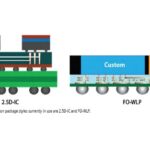ASIA ELECTRONICS INDUSTRYYOUR WINDOW TO SMART MANUFACTURING
Intel Steps Forward with Loihi 2 Neuromorphic Chip
Intel has unveiled Loihi 2, its second-generation neuromorphic research chip, and Lava, an open-source software framework for developing neuro-inspired applications.
The release is a testimony to Intel’s ongoing progress in advancing neuromorphic technology, as global chip are scrambling to reverse-engineer the way that human brain works to create neuromorphic ICs
“Loihi 2 and Lava harvest insights from several years of collaborative research using Loihi. Our second-generation chip greatly improves the speed, programmability, and capacity of neuromorphic processing, broadening its usages in power and latency constrained intelligent computing applications. We are open sourcing Lava to address the need for software convergence, benchmarking, and cross-platform collaboration in the field, and to accelerate our progress toward commercial viability, ” Mike Davies, director of Intel’s Neuromorphic Computing Lab
Trying to draw telltales from neuroscience to create chips that function more like the biological brain, neuromorphic computing promises to deliver orders of magnitude improvements in energy efficiency, speed of computation and efficiency of learning across a range of edge applications.
Applications are plentiful from vision, voice and gesture recognition to search retrieval, robotics, and constrained optimization problems.
Intel and its partners have demonstrated that the chip can be applied for robotic arms, neuromorphic skins, and olfactory sensing.
Self-learning
The research chip incorporates learnings from three years of use with the first generation of research chip.
It also leverages progress in Intel’s process technology and asynchronous design methods.
These advances allow the architecture to support new classes of neuro-inspired algorithms and applications, while providing up to 10 times faster processing1, up to 15 times greater resource density2 with up to 1 million neurons per chip, and improved energy efficiency.
Benefitting from a close collaboration with Intel’s Technology Development Group, Loihi 2 has been fabricated with a pre-production version of the Intel 4 process.
The use of extreme ultraviolet (EUV) lithography in Intel 4 has simplified the layout design rules compared to past process technologies. This has made it possible to rapidly develop Loihi 2.
Technology advances don’t stop there. The Lava software framework is a sort of open, modular, and extensible framework that allows researchers and application developers to seamlessly work together to build on each other’s progress and converge on a common set of tools, methods, and libraries.
Lava runs seamlessly on heterogeneous architectures across conventional and neuromorphic processors, enabling cross-platform execution and interoperability with a variety of artificial intelligence, neuromorphic and robotics frameworks.
Developers can begin building neuromorphic applications without access to specialized neuromorphic hardware and can contribute to the Lava code base, including porting it to run on other platforms.
“Investigators at Los Alamos National Laboratory have been using the Loihi neuromorphic platform to investigate the trade-offs between quantum and neuromorphic computing, as well as implementing learning processes on-chip,” said Dr. Gerd J. Kunde, staff scientist, Los Alamos National Laboratory.
Open-source Cross-Platform

Combined, Loihi 2 and Lava provide tools for researchers to develop and characterize new neuro-inspired applications for real-time processing, problem-solving, adaptation and learning.
For example, Loihi 2’s greater programmability will allow a wider class of difficult optimization problems to be supported, including real-time optimization, planning, and decision-making from edge to datacenter systems.
It also improves support for advanced learning methods, including variations of backpropagation, the workhorse algorithm of deep learning.
This expands the scope of adaptation and data efficient learning algorithms that can be supported by low-power form factors operating in online settings.
As with the case, fully programmable neuron models and generalized spike messaging in Loihi 2 open the door to a wide range of new neural network models that can be trained in deep learning. Early evaluations suggest reductions of over 60 times fewer ops per inference on Loihi 2 compared to standard deep networks running on the original Loihi without loss in accuracy3.
Loihi 2 also addresses a practical limitation of Loihi by incorporating faster, more flexible, and more standard input/output interfaces, ensuring seamless integration with real-world robotics systems, conventional processors, and novel sensors. It will support Ethernet interfaces, glueless integration with a wider range of event-based vision sensors, and larger meshed networks of Loihi 2 chips.
From Lab to Market
Advancing neuromorphic computing from laboratory research to commercially viable technology is a three-pronged effort.
It requires continual iterative improvement of neuromorphic hardware in response to the results of algorithmic and application research; development of a common cross-platform software framework so developers can benchmark, integrate, and improve on the best algorithmic ideas from different groups; and deep collaborations across industry, academia and governments to build a rich, productive neuromorphic ecosystem for exploring commercial use cases that offer near-term business value.




